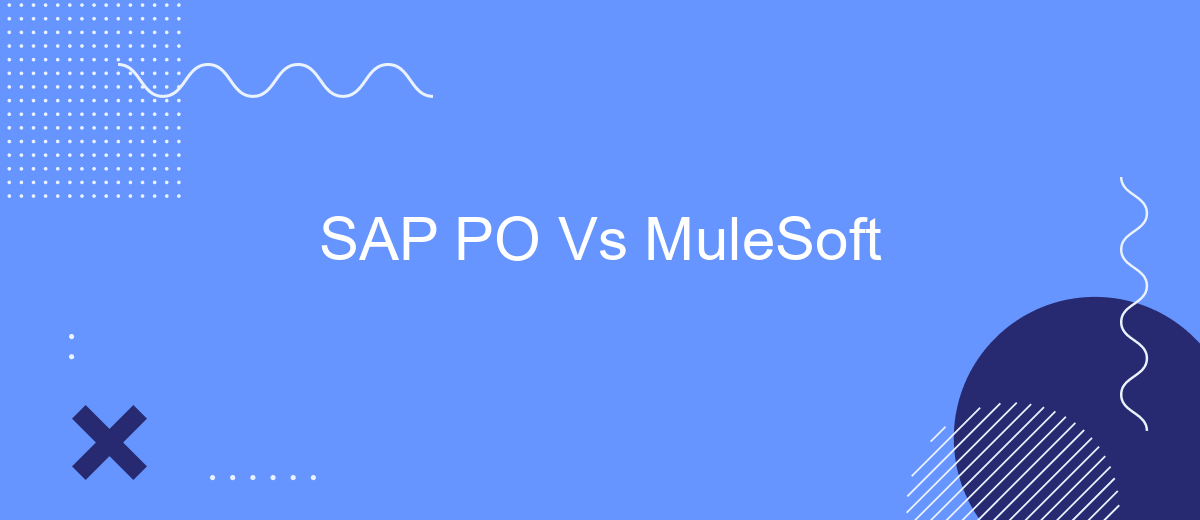In today's rapidly evolving digital landscape, businesses seek robust integration platforms to streamline operations and enhance connectivity. SAP Process Orchestration (PO) and MuleSoft are two leading solutions in this domain. This article delves into a comparative analysis of SAP PO and MuleSoft, exploring their features, strengths, and use cases to help organizations make informed decisions on which platform best suits their integration needs.
Introduction
In today's rapidly evolving digital landscape, businesses are increasingly relying on integration platforms to streamline their processes and enhance operational efficiency. Two prominent players in this arena are SAP Process Orchestration (SAP PO) and MuleSoft. Both platforms offer robust solutions for integrating diverse systems, applications, and data sources, but they cater to different needs and have unique strengths.
- SAP PO: A comprehensive middleware platform designed for SAP environments, providing seamless integration with SAP and non-SAP systems.
- MuleSoft: A versatile integration platform known for its API-led approach, enabling connectivity across a wide range of applications and services.
Choosing the right integration platform is crucial for businesses aiming to optimize their workflows and ensure smooth data exchange. Platforms like SaveMyLeads can further enhance these integration efforts by automating lead data transfer between various systems, making it easier for businesses to manage their customer relationships and marketing activities. Understanding the differences between SAP PO and MuleSoft can help organizations make informed decisions tailored to their specific integration needs.
SAP PO Overview

SAP Process Orchestration (SAP PO) is a comprehensive middleware platform designed to facilitate seamless integration of various business applications and processes. It combines the functionalities of SAP Process Integration (PI), SAP Business Process Management (BPM), and SAP Business Rules Management (BRM) into a unified environment. This allows organizations to design, execute, and monitor end-to-end business processes, ensuring smooth data flow and efficient communication between disparate systems.
One of the key features of SAP PO is its ability to support various integration scenarios, including application-to-application (A2A) and business-to-business (B2B) integrations. It offers robust tools for mapping, routing, and transforming data, making it easier to connect different applications and services. Additionally, platforms like SaveMyLeads can complement SAP PO by providing pre-built connectors and automated workflows, further simplifying the integration process and enhancing overall operational efficiency.
MuleSoft Overview

MuleSoft is a widely recognized integration platform that enables businesses to connect applications, data, and devices seamlessly. It offers a robust set of tools for developing, deploying, and managing APIs and integrations in a scalable and secure manner. MuleSoft's Anypoint Platform is designed to support a wide range of integration needs, from simple data synchronization to complex, multi-system orchestration.
- Anypoint Studio: An intuitive, Eclipse-based IDE for designing and testing Mule applications.
- Anypoint Exchange: A marketplace for connectors, templates, and APIs to accelerate development.
- Anypoint Management Center: A centralized interface for monitoring and managing integrations in real-time.
- Anypoint Connectors: Pre-built connectors for popular applications and services, including Salesforce, SAP, and many others.
With its powerful capabilities, MuleSoft facilitates the rapid development of integration solutions, enabling businesses to streamline operations and enhance agility. Additionally, services like SaveMyLeads can complement MuleSoft by automating lead data transfers between various platforms, further simplifying the integration process. Together, these tools help organizations achieve seamless connectivity and operational efficiency.
Comparison of Key Features

SAP PO and MuleSoft are two prominent integration platforms that offer a range of features to streamline business processes. Each platform has its strengths and caters to different needs, making it essential to understand their key features for an informed decision.
SAP PO (Process Orchestration) is known for its robust integration capabilities within the SAP ecosystem. It is highly effective for businesses already using SAP products, providing seamless integration and orchestration of business processes. MuleSoft, on the other hand, is recognized for its versatility and ability to connect a wide variety of applications, data, and devices, making it a strong contender for diverse IT environments.
- Integration Capabilities: SAP PO excels in SAP-centric environments, while MuleSoft offers broader integration across multiple systems.
- User Experience: MuleSoft provides a more intuitive interface with its Anypoint Platform, whereas SAP PO may require more specialized knowledge.
- Scalability: Both platforms are scalable, but MuleSoft's cloud-native architecture offers additional flexibility.
- Pre-built Connectors: MuleSoft boasts an extensive library of pre-built connectors, while SAP PO is more focused on SAP applications.
- Support and Community: MuleSoft has a large, active community and extensive documentation. SAP PO benefits from SAP's robust support network.
For businesses looking to simplify their integration processes, services like SaveMyLeads can offer valuable assistance by automating lead data transfers and integrations across various platforms. This can be particularly beneficial for companies aiming to enhance their CRM systems without extensive manual effort.
Conclusion
In conclusion, both SAP PO and MuleSoft offer robust integration capabilities tailored to different business needs. SAP PO excels in environments heavily invested in SAP landscapes, providing seamless integration with SAP applications. On the other hand, MuleSoft stands out with its versatility and ease of use, making it a strong contender for organizations seeking a more flexible and broad-spectrum integration platform.
Choosing between SAP PO and MuleSoft depends largely on your organization's existing infrastructure and future growth plans. For businesses looking to streamline their integration processes with minimal effort, services like SaveMyLeads can be invaluable. SaveMyLeads simplifies the integration of various applications, ensuring that your business processes remain efficient and uninterrupted. Ultimately, the right choice will align with your specific requirements, ensuring scalability, reliability, and ease of management.


FAQ
What are the main differences between SAP PO and MuleSoft?
Which platform is better for integrating non-SAP systems?
How does the learning curve compare between SAP PO and MuleSoft?
Can I use both SAP PO and MuleSoft together?
What services are available for automating integration tasks?
If you use Facebook Lead Ads, then you should know what it means to regularly download CSV files and transfer data to various support services. How many times a day do you check for new leads in your ad account? How often do you transfer data to a CRM system, task manager, email service or Google Sheets? Try using the SaveMyLeads online connector. This is a no-code tool with which anyone can set up integrations for Facebook. Spend just a few minutes and you will receive real-time notifications in the messenger about new leads. Another 5-10 minutes of work in SML, and the data from the FB advertising account will be automatically transferred to the CRM system or Email service. The SaveMyLeads system will do the routine work for you, and you will surely like it.
